Irrigation is an art. Water too little and the turf dies, too much and turf diseases pop up. Diseases such as powdery mildew, fairy ring, slime mold, red threat and rust are common in turf. It is impossible to control the weather, you can learn how to take steps to prevent turf issues. Having up to date irrigation systems and proper drainage can help you better plan for rain every season.
Powdery Mildew
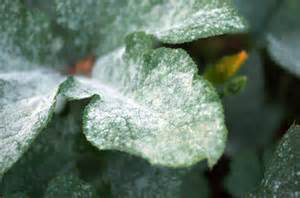 Powdery mildew is a fungal disease. It can affect a wide range of plants, leaving leafs’ surfaces white. The lower leaves will be affected the most. However, any above-ground part of the plant can display the mildew. The mildew will thrive in high humidity and moderate temperature environments. This disease appears most in the spring and fall. Cool, cloudy conditions, and shade are feeding grounds for this disease.
Powdery mildew is a fungal disease. It can affect a wide range of plants, leaving leafs’ surfaces white. The lower leaves will be affected the most. However, any above-ground part of the plant can display the mildew. The mildew will thrive in high humidity and moderate temperature environments. This disease appears most in the spring and fall. Cool, cloudy conditions, and shade are feeding grounds for this disease.
Fairy Ring
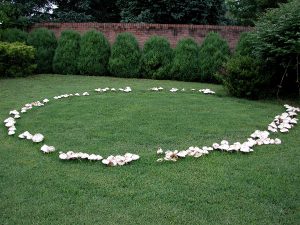 Cursing all grass species year around, Fairy Ring is caused by more than 50 pathogens. There are three different types of Fairy Ring. The first causes a zone of dead turf. Secondly, a ring of accelerated turf growth will occur. Lastly, a ring of mushrooms may form. Multiple steps are needed to be taken to manage this infestation. Steps can include aerating, use of wetting agents, water management and a fertilizing strategy. For further information about fairy ring click here.
Cursing all grass species year around, Fairy Ring is caused by more than 50 pathogens. There are three different types of Fairy Ring. The first causes a zone of dead turf. Secondly, a ring of accelerated turf growth will occur. Lastly, a ring of mushrooms may form. Multiple steps are needed to be taken to manage this infestation. Steps can include aerating, use of wetting agents, water management and a fertilizing strategy. For further information about fairy ring click here.
Slime Mold
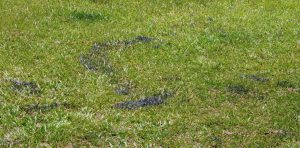 Slime mold just as it sounds, appears as a slimy black or white substance. Affecting all types of turf grass, this mold flourishes in the cooler months. Although it usually disappears in a few weeks, this nuisance can appear yearly after getting once. Thankfully, slime mold is not typically harmful to turf, just unsightly. Frequent mowing, rinsing and aeration of the lawn can dissipate the mold. For further information about slime mold click here.
Slime mold just as it sounds, appears as a slimy black or white substance. Affecting all types of turf grass, this mold flourishes in the cooler months. Although it usually disappears in a few weeks, this nuisance can appear yearly after getting once. Thankfully, slime mold is not typically harmful to turf, just unsightly. Frequent mowing, rinsing and aeration of the lawn can dissipate the mold. For further information about slime mold click here.
Red Thread
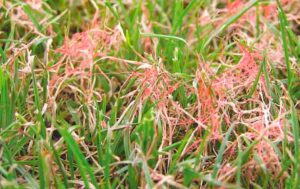 Red thread appears during warm, humid, and cloudy months. As the most common turf grass disease, it is often found in lawns using low nitrogen fertilizer. The disease first appears in small patches with white and cream colored blades. It is managed by pruning trees and shrubs. This is to promote canopy drying and to increase nitrogen fertility. For further information about red thread click here.
Red thread appears during warm, humid, and cloudy months. As the most common turf grass disease, it is often found in lawns using low nitrogen fertilizer. The disease first appears in small patches with white and cream colored blades. It is managed by pruning trees and shrubs. This is to promote canopy drying and to increase nitrogen fertility. For further information about red thread click here.
Rust
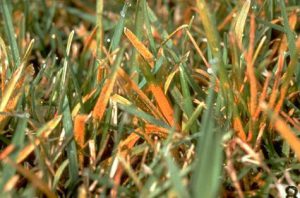 This disease causes thinning in the turf but will not kill the host plant. First appearing as yellowish spots, these spots develop into orange or red blister-like areas filled with orange or yellow spores. The nitrogen fertility is the most effective management technique. For further information about rust click here.
This disease causes thinning in the turf but will not kill the host plant. First appearing as yellowish spots, these spots develop into orange or red blister-like areas filled with orange or yellow spores. The nitrogen fertility is the most effective management technique. For further information about rust click here.
A Watchful Eye
Applying too much or not enough water can result in unhealthy, slow-growing grass that is vulnerable to pathogens. Water deeper, not more. Deeply watered lawn forces grass roots to reach further in the soil. This develops deeper and stronger roots. This provides grass with greater drought and disease resistance than a shallowly watered lawn.
Keep an attentive eye on your client’s turf. Turf should be inspected once a week to immediately identify problems and act quickly to determine the cause before it’s too late. Diseases tend to start off as small patches or spots of dying grasses that spread over time.
During the rainy seasons, drainage can also contribute to turf diseases. Drainage is important in healthy greens. Poor draining soils, improper grade and irrigation are usually the cause of drainage problems. Talk to your local Wolf Creek Company Representative with any questions.











